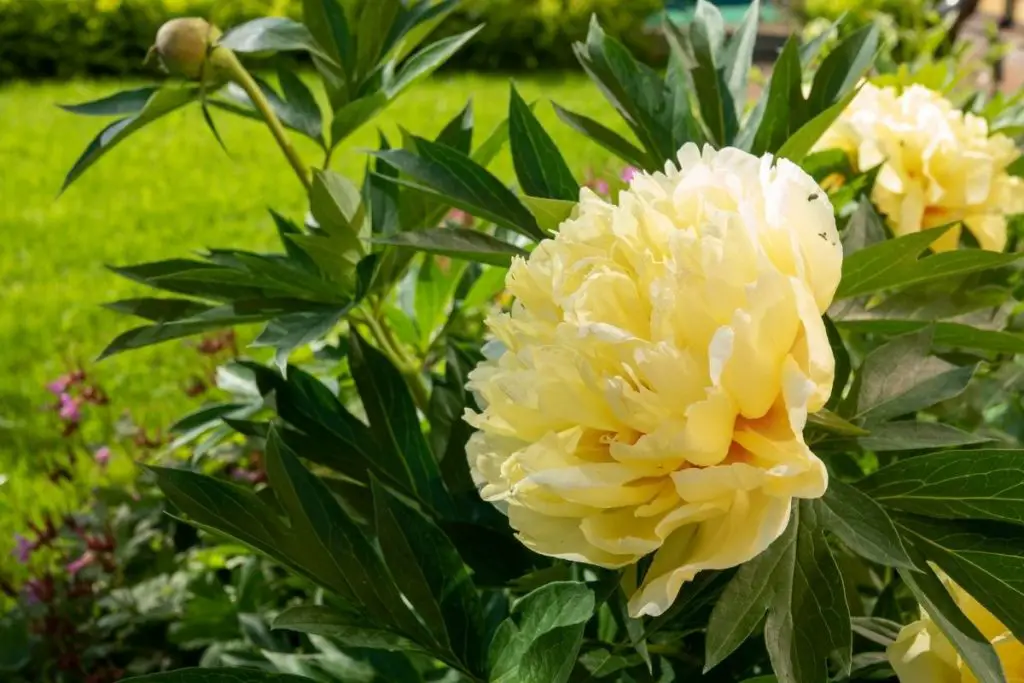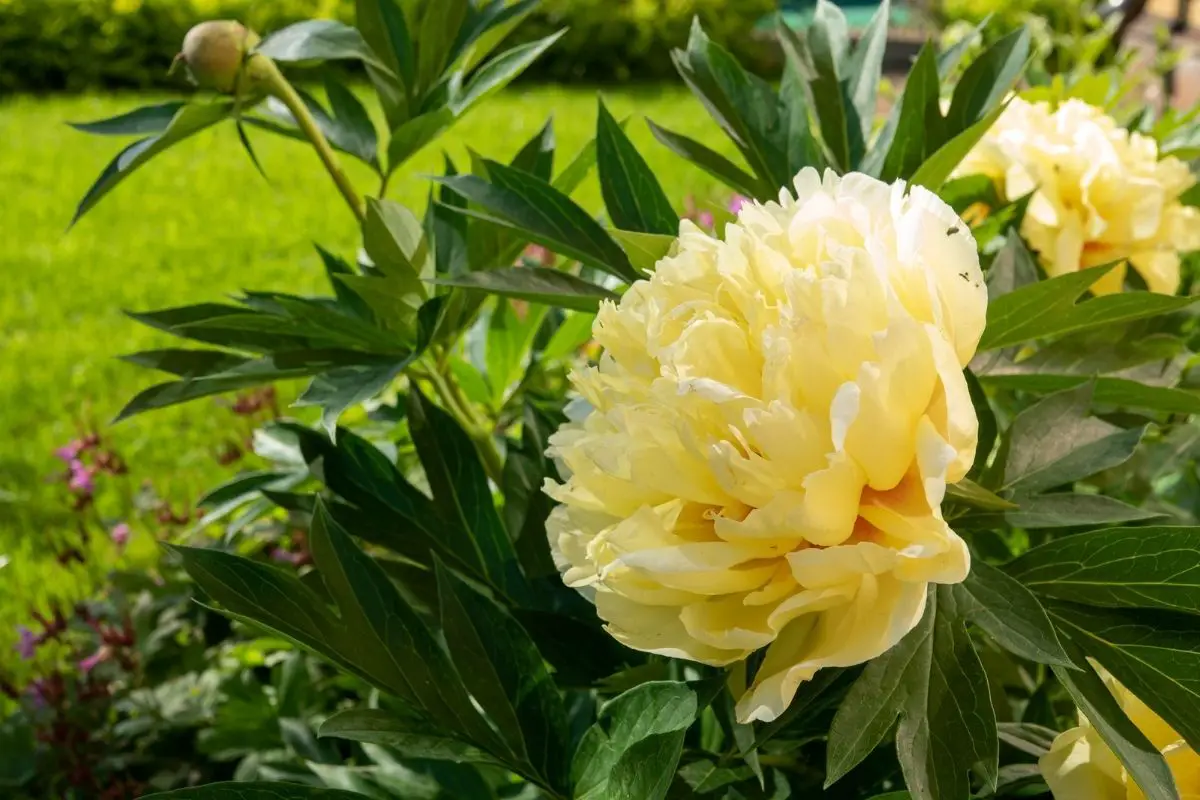Itoh or intersectional peonies are the hybrids of herbaceous peony Paeonia lactiflora and hybrid lutea tree peonies. Their flowers and leaves resemble those of tree types, whereas growth habits and forms more closely resemble herbaceous types.
Peonies are low maintenance and long-living plants with lovely flowers, which would make a nice addition to cottage-style gardens.
History
Itoh peonies are named after Tochi Itoh, a Japanese breeder who was historically the first person to succeed (where many before him had failed), in creating a herbaceous tree peony hybrid in the 1960s. Since then, many North American breeders have also been successful.
These plants flower from late spring to early summer and have large, bowl-shaped flowers. Varieties come in a range of colors and have forms such as single, semi-double, and fully double. Unlike herbaceous and tree peonies types, they bloom for up to three weeks (possibly longer where the spring warm-up stays cool).
Plant Facts
| Scientific name | Paeonia spp. |
| Common names | Itoh Peony, Intersectional Peony, Itohs |
| Genus | Paeonia |
| Family | Paeoniaceae |
| Height | 1.ft 6 in. – 4ft. 0 in. |
| Width | 1ft. 6 in. – 4ft. 0 in. |
| USDA Plant Hardiness Zone | 3a, 3b, 4a, 4b, 5a, 5b, 6a, 6b, 7a, 7b, 8a, 8b |
| Origin | Japan |
| Flower colors | Red, Pink, Yellow, Orange, White, Cream, Purple |
| Blooming season | 21 days (possibly longer) in late spring-early summer |
| Plant/Flower special features | Large, showy flowers |
How to Plant and Grow Itoh Peony Bulbs
Plant them in fall before the winter frost. They should be in a sheltered site, but away from trees or large shrubs as they don’t fare well with competition.

Growing Itoh Peony Flowers in a Bed
Dig a hole as deep and twice the width of the root ball. Place the bulb with its red-eye bud 1 inch deep in the soil. Water thoroughly and regularly until the plants are established. Leave at least 3 feet spacing between plants.
Plants may need extra support to stop their stems from bending under the weight of their flowers. Stake and ring them when shoots are small to prevent any damage to emerging shoots.
Growing Itoh Peony Flowers in a Pot
Grow them in pots using the same guidelines as beds. Choose a well-draining container and take care not to overwater.
Propagation
Propagate Itoh peony flowers by division. Seeding is not possible since Itohs are sterile.
Division
Wait until fall after the foliage has been cut down to divide. Plant the divisions before the first frost so the roots can become acclimated.
Gently take the plant out of the ground, keeping the root system intact. Remove any soil on the roots to expose them and any newly forming buds.
Divide the crown into sections containing at least 3 new growth buds and some roots. Plant the new sections in the ground with red-eyes 1 inch below the soil line. Plants will take up to 2 years to flower.

Care and Maintenance
Soil
Itoh peonies should be in a well-draining, fertile, and slightly acidic soil. Before planting, amend the soil with either well-rotted manure or compost. You can also add a small amount of bone meal.
Water
During establishment in the first year, plants need regular watering. After that water regularly during dry periods only.
Water the soil to a depth of 12-18 inches, and allow the soil to dry out fully in between waterings.
Fertilizer
Itoh peony plants need fertilizing in spring and again after flowering. Use a general-purpose fertilizer at 20oz per square yard and apply around the crown of the plant.
Mulching with compost or well-rotted manure will help to suppress weeds and conserve moisture. Every few years, apply a handful of bone meal to the soil around the plant.
Sunlight
Itoh peony bushes require full sunlight. Those that are grown in shady areas will produce fewer blooms.
Temperature and Humidity
Itoh peonies are hardy to USDA zones 3-8 and need a cold period to bloom.
Pest and diseases
Itoh peonies are more resistant to disease than other types, but can still get powdery mildew, Peony blotch, Peony wilt, and blight (Botrytis and Phytophthora). Peony wilt is serious, and any infected parts need to be cut away and safely burned.
Plants may get infested with Thrips, if found remove any affected leaves and stems. They may attract ants, but these will not harm the plant.
Pruning
Prune the spent flowers and disbud to promote bigger central blooms. Cut the foliage back down to the ground every fall to limit the risk of Peony wilt disease.
Toxicity
Plants are mildly toxic to people and animals. Symptoms of poisoning include nausea, vomiting, and diarrhea.
Uses of the Itoh Peony
These plants are popular and highly sought out ornamentals for the garden. Their flowers make particularly lovely cut flowers and bouquets.
Common Varieties and Cultivars
With so many peony types with beautiful color combinations and forms, choosing the right variety for your garden can seem like a daunting task. Below are some popular Itoh varieties and cultivars:
- Paeonia “Bartzella”
- Paeonia “Garden Treasure”
- Paeonia “Kopper Kettle”
- Paeonia “Mountain Lilac”
- Paeonia “Singing in the Rain”
Conclusion
Itoh peonies are crosses between herbaceous P. lactiflora and woody lutea hybrids. They are long-lived perennials that will bring delight to the garden year after year. These plants are highly sought after, low maintenance, and perfect for cottage-style gardens.
First bred in Japan by their namesake Tochi Itoh, these beautiful blooms are a top choice for bouquets and as cut flowers.
~ image source: depositphotos/spotluda

